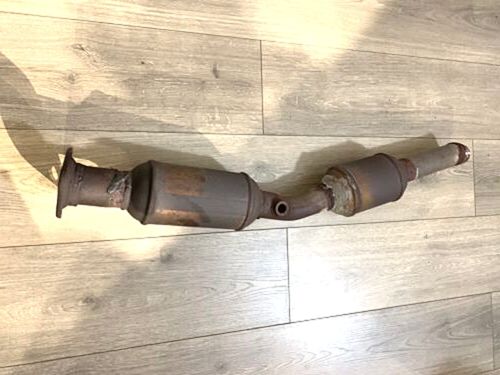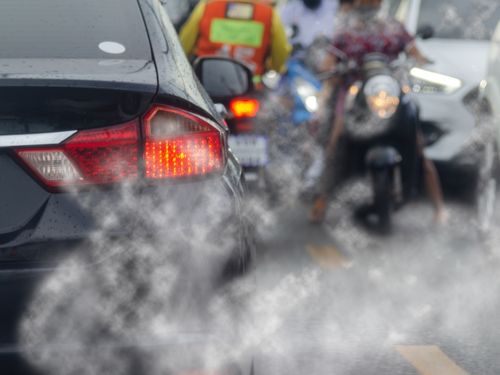The catalytic converter is one of the most important emissions control devices on a modern car and it plays a vital role in reducing emissions. However, this important piece of equipment can eventually go bad, causing a number of problems for the vehicle.
But what causes the catalytic converter to go bad?
We did some research and asked automotive professionals to find out 14 of the most common reasons why a catalytic converter may fail. These include:
- Poor engine maintenance
- Age and mileage
- Overheating
- Faulty oxygen sensor
- Unburned fuel in the exhaust system
- Oil or antifreeze entering the exhaust system
- Low coolant level
- Bad spark plugs or spark plug wires
- Damage to the honeycomb structure
- Short trips
- Road or structural damage
- Fuel additives
- Exhaust leaks
- Faulty valve seals
Sometimes, a failing converter can be repaired, but in other cases, it will need to be replaced.
In the next section, we’ll discuss each of these causes in detail as understanding the causes of catalytic converter failure can help you keep your vehicle running smoothly and help you avoid costly repairs.

Table of Contents
- What Causes the Catalytic Converter to Go Bad?
- Age and mileage
- Poor engine maintenance
- Overheating
- Faulty oxygen sensor
- Unburned fuel in the exhaust system
- Oil or antifreeze entering the exhaust system
- Low coolant level
- Bad spark plugs or spark plug wires
- Damage to the honeycomb structure
- Short trips
- Road or structural damage
- Fuel additives
- Exhaust leaks
- Faulty valve seals and piston rings
- Signs and Symptoms Of A Bad Catalytic Converter
- Can You Drive With A Bad Catalytic Converter?
- How Much Does It Cost To Replace A Catalytic Converter?
- Frequently Asked Questions
- Conclusion
What Causes the Catalytic Converter to Go Bad?
There are several reasons why a catalytic converter may fail, including age, unburned fuel in the exhaust system, damage to the honeycomb structure, or faulty oxygen sensors.
Let’s take a closer look at each of these causes.
Age and mileage
Ideally, a catalytic converter is designed to last the lifetime of the vehicle, but it can eventually go bad due to age and mileage.
Over time, the honeycomb structure inside the converter can become clogged with carbon deposits, restricting exhaust flow and causing the converter to overheat.
In addition, the catalyst material can deteriorate, decreasing its ability to convert emissions.
Poor engine maintenance
One of the most common reasons for catalytic converter failure is poor engine maintenance.
It’s important to keep up with regular oil changes and tune-ups to prevent deposits from building up in the engine and clogging the converter. Using the wrong type of oil or fuel can also lead to deposits that can damage the converter.
Most modern cars will periodically remind you to service the engine, so be sure to follow the manufacturer’s recommended maintenance schedule.
Overheating
Catalytic converters work closest to one of the hottest parts of your vehicle – the engine.
As a result, it can become damaged if they overheat due to a clogged filter, restricted exhaust flow, or an overheated engine.
If the converter becomes too hot, the honeycomb structure inside can melt, damaging the converter beyond repair.
Faulty oxygen sensor
The oxygen sensor is responsible for monitoring the amount of oxygen in the exhaust system.
If it senses that there’s too much or too little oxygen, it will adjust the air/fuel mixture accordingly.
If the oxygen sensor is faulty, it can cause the engine to run too lean or too rich, which can damage the catalytic converter.
Thankfully, most modern cars will immediately throw a “check engine light” error code if the oxygen sensor isn’t working properly or if your catalytic converter is bad.
You should take your car to a mechanic and have it checked out as soon as possible.
On a side note, if you see a check engine light error, it may also mean your catalytic converter has been stolen. Look for these signs if you suspect catalytic converter theft.
Unburned fuel in the exhaust system
Another common cause of converter failure is unburned fuel in the exhaust system. This can happen if the engine is running too lean (not enough fuel) or if the spark plugs are fouled, causing the engine to misfire.
Unburned fuel can damage the catalyst material, causing it to lose its ability to convert emissions efficiently.
In addition, unburned fuel can also cause the converter to overheat and damage the honeycomb structure.
Oil or antifreeze entering the exhaust system
If oil or antifreeze enters the exhaust system, it can coat the catalyst material and prevent it from working properly.
Additionally, oil or antifreeze build-up can also clog the air passage to the honeycomb structure inside the converter.
It can further lead to two significant problems:
- The carbon deposits will stop the catalytic converter from doing its job
- Restricting the exhaust flow will increase backpressure
These problems can cause the converter to overheat and the excess backpressure can cause internal engine damage which would be very costly to repair.
Low coolant level
Coolant is used to keep the engine from overheating and it should be properly maintained at all times.
If the coolant level gets too low, it can cause the engine to overheat and damage the catalytic converter.
In addition, low coolant levels can also lead to engine damage, so it’s important to keep an eye on the coolant level and top it off as needed.
Bad spark plugs or spark plug wires
While it’s not very common, bad spark plugs or spark plug wires can cause the engine to misfire, which can damage the catalytic converter.
Misfiring can also cause unburned fuel to enter the exhaust system, which we mentioned earlier is one of the most common causes of converter failure.
If you suspect that your spark plugs or wires are bad, it’s important to have them replaced as soon as possible.
Damage to the honeycomb structure
The honeycomb structure inside the catalytic converter can be damaged by physical impact or by excessive vibration.
Additionally, the structure can also become damaged over time due to the high temperatures and harsh chemicals inside the converter.
Once the honeycomb structure is damaged, it can’t be repaired and the entire converter will need to be replaced which can be costly.
Short trips
If you frequently drive short distances, your catalytic converter may not have enough time to reach its operating temperature.
If you look at how a catalytic converter works, you’d notice that it needs to be heated up to its operating temperature in order to work properly.
If it’s not heated up, the unburned fuel and emissions will build up inside the converter and damage it. Over time, this can cause the converter to fail and will need to be replaced.
So, if you frequently drive short distances, it’s important to take your car on a long drive every once in a while to give the converter a chance to reach its operating temperature.
Road or structural damage
If you hit a large pothole or other road hazards, it can damage the undercarriage of your car which can lead to catalytic converter damage.
Additionally, if you drive over uneven roads too fast, it can also cause the converter to break loose and be damaged.
While it’s not very common, physical damage to the converter can occur and it’s important to be aware of it.

Fuel additives
Using fuel additives can sometimes reduce the effectiveness of a catalytic converter.
Certain types of fuel additives can coat the catalyst material and prevent it from working properly.
In addition, some fuel additives can also clog the honeycomb structure inside the converter and cause damage.
If you’re using fuel additives, be sure to read the label carefully and only use the fuel additives that are specially designed to be used with catalytic converters.
Exhaust leaks
An exhaust leak is when exhaust gases that are made inside the engine’s combustion chamber escape from the car through a leak in the exhaust system.
Exhaust leaks can allow more hot air, unburned fuel, and emissions to enter the catalytic converter which can damage it.
In addition, exhaust leaks can also cause the converter to overheat and fail.
If you suspect that you have an exhaust leak, it’s important to have it repaired as soon as possible.
Faulty valve seals and piston rings
Faulty valve seals and piston rings can cause oil and other fluids to enter the combustion chamber and be burned along with the fuel.
This can lead to the formation of sludge and deposits inside the engine which can eventually make their way into the catalytic converter.
Once these deposits build up inside the converter, they can clog and damage the honeycomb structure and cause it to fail.
Signs and Symptoms Of A Bad Catalytic Converter
While it’s important to understand what causes the catalytic converter to go bad, you should also be aware of the signs and symptoms that indicate that your converter is failing.
The most common sign of a bad catalytic converter is an increase in exhaust fumes and a decrease in engine performance. Also, if you notice that your engine is misfiring, stalling, or has a loss of power, it’s possible that your converter is to blame.
The most common signs and symptoms of a bad catalytic converter are:
- Increase in dark exhaust fumes
- Your vehicle is very loud
- Check engine light is ON
- Low-end torque is reduced
- You are getting a headache when your windows are down
- Lower fuel efficiency
Let’s now discuss each of these signs and symptoms that you might experience if your catalytic converter is failing and needs to be replaced.
Increase in dark exhaust fumes
If you notice that your car’s exhaust fumes are darker than usual, it’s an indication that the catalytic converter is not working properly.
The catalytic converter is designed to filter and reduce the amount of harmful emissions produced by the engine so, in ideal conditions, exhaust fumes are almost invisible.
However, if the catalytic converter is missing or not working properly, those emissions will escape from the car without filtration and be released into the environment.

Your vehicle is very loud
If you notice that your car is suddenly much louder than it used to be, it’s another symptom of a failing catalytic converter.
The converter is designed to muffle the noise produced by the engine so if it’s not working correctly, you’ll definitely notice an increase in noise.
Check engine light is ON
One of the most obvious signs that something is wrong with your car’s catalytic converter is if the check engine light comes on.
This light comes on when the ECM detects an issue with the oxygen sensor in the vehicle and it’s a good indication that something needs to be repaired or replaced.
Low-end torque is reduced
Low-end torque is the force that’s produced by the engine when it’s first turned on and at slow speeds and it is responsible for providing power to the wheels.
If you notice that your car’s low-end torque is reduced, it means that the engine isn’t producing as much power as it should be. This is often caused by a bad catalytic converter.
You are getting a headache when your windows are down
If you drive with your windows down and you start to get a headache, it’s a sign that the fumes from your car’s exhaust are making their way into the cabin.
A bad or missing catalytic converter is the most likely cause of this problem.
Lower fuel efficiency
Lastly, if you notice that your car’s fuel efficiency has decreased, it could be a sign that the catalytic converter is going bad.
The converter helps to reduce the number of harmful emissions produced by the engine and if it’s not working correctly, your car will use more fuel to start and run.
Can You Drive With A Bad Catalytic Converter?
The short answer is yes, you can drive with a bad catalytic converter but it’s not recommended.
A failing catalytic converter doesn’t directly affect the engine so the car will still start and run but there are a few reasons why you shouldn’t drive with a bad converter.
The most important reason is that a failing converter can’t filter the harmful emissions produced by the engine so those fumes will be released into the environment.
Additionally, a bad converter can cause your car to run less efficiently which will lead to an increase in fuel consumption.
Moreover, in most states, you can be pulled over and fined for driving with a bad catalytic converter since the emissions produced by your car will fail the smog test.
How Much Does It Cost To Replace A Catalytic Converter?
The cost of replacing a catalytic converter will vary depending on the make and model of your car but it typically costs between $500 and $2000. For luxury cars, the cost can go up to $7000 since they require a more expensive converter.
In the below table, we’ve listed the five cars that have the most expensive catalytic converters.
Cars | Catalytic Converter Value |
Ferrari F430 | $3,770 (2 units) |
Lamborghini Aventador | $3,120 (2 units) |
Ram 2500 | $3,460 |
Ford F-250 | $2,804 |
Ford Mustang | $1,500 |
The best way to get an accurate estimate is to take your car to a mechanic or dealership and have them diagnose the problem.
Once they know for sure that the converter needs to be replaced, they’ll be able to give you a more accurate estimate.
Frequently Asked Questions
What is most likely to cause catalytic converter failure?
The most common cause is aging. Over time, the converter can become clogged with debris or damaged which will cause it to fail.
Can a bad catalytic converter damage your engine?
In general, a bad catalytic converter will not damage your engine but other problems leading from a failing catalytic converter it may affect the engine’s performance.
How do you fix a catalytic converter without replacing it?
If the converter is only slightly damaged, you may be able to clean it and fix the problem. Using high-octane fuel or catalytic converter cleaner or liquid thinner can help to remove the build-up of debris and deposits.
Do catalytic converter cleaners work?
Yes and no, catalytic converter cleaners may help to remove deposits and build-up but it’s not a guarantee. If you read reviews of popular catalytic converter cleaners, there’s a mix of people who say it worked and those who didn’t see any difference.
Conclusion
A catalytic converter is a crucial part of your car’s exhaust system and it helps to reduce the harmful emissions produced by the engine.
If the converter goes bad, it can cause a number of problems for your car including reduced fuel efficiency and decreased performance.
You should look at the above 14 causes if you think your catalytic converter might be going bad.
In most states, it’s also illegal to drive with a bad catalytic converter, and your car will most likely fail the emission test so it’s best to get it replaced as soon as possible.

Robert Bacon is a car nerd and automotive lover who has dedicated his life to understanding the inner workings of vehicles. He holds a degree in mechanical engineering and has spent years working as a mechanic and engineer for some of the world’s top car companies. In his spare time, he enjoys writing about cars on this blog and tinkering with his 2016 Toyota Mirai in his garage.